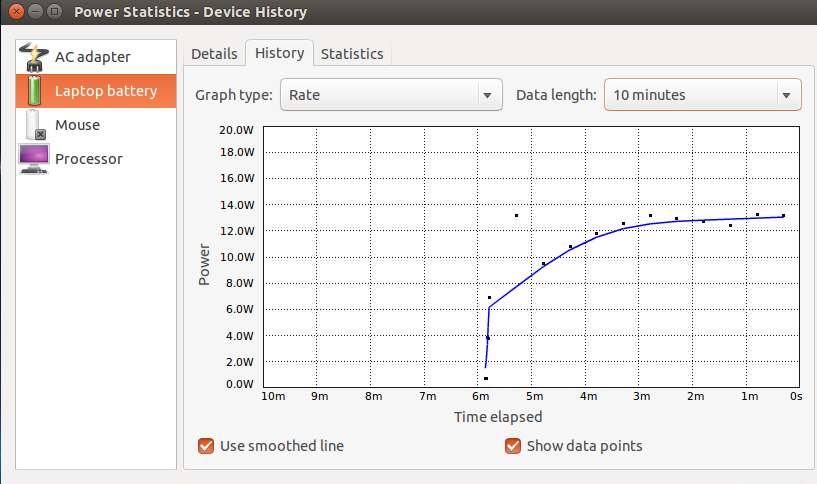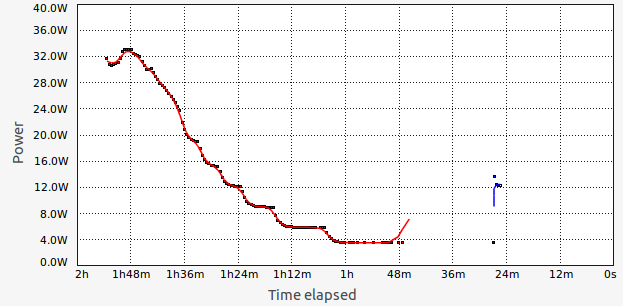 Ubuntu visualizes current and previous power consumption and recharge behavior in a couple of nice graphs as shown in the screenshots above and below. When I have screen brightness quite high but not much else is going on, my notebook draws around 12-13 Watts of power and my battery lasts around 4 hours. Turning up brightness, running a virtual machine or two and streaming a video from Youtube and power consumption is obviously significantly higher. Sometimes it would be nice, however, to not only see a graph but to get a reading of how much power my notebook takes at any point in time. Fortunately there’s a command for that.
Ubuntu visualizes current and previous power consumption and recharge behavior in a couple of nice graphs as shown in the screenshots above and below. When I have screen brightness quite high but not much else is going on, my notebook draws around 12-13 Watts of power and my battery lasts around 4 hours. Turning up brightness, running a virtual machine or two and streaming a video from Youtube and power consumption is obviously significantly higher. Sometimes it would be nice, however, to not only see a graph but to get a reading of how much power my notebook takes at any point in time. Fortunately there’s a command for that.
And here it is what the command and the response looks like:
cat /sys/class/power_supply/BAT0/power_now 1299100
The response translates into a current power consumption of 12.99 watts. When running two virtual machines in which all programs are currently doing nothing, power consumption jumps up over 14.5 watts. Not a lot of difference when your are connected to the mains but a watt or two more or less makes a lot of difference when you are running on a battery. If I dim the screen I can get power consumption down to 10 watts but it has to be pitch black in the room for this setting to be actually useful.
Coming back to the nice graphs Ubuntu generates I have another one at the end of the post that shows how the notebook reduces the charge rate around 45 minutes before the battery is completely full from an initial 32 watts down almost 0 as charging has to slow down once the battery is almost full to avoid damage.

Interesting feature. I am running Debian GNU/Linux 8 “Jessie” AMD64 on a Dell Latitude E6410. For me it is
cat /sys/class/power_supply/BAT0/current_now
1838000 (for screen brightness turned all the way down)
2083000 (medium screen brightness)
Other hardware effecting power draw are:
– 6GB of Ram installed
– Samsung 850 EVO 500GB
– Intel i5 CPU M 560
I wonder why mine draws so much more power. Sauer already mentioned in this blog that he has a lot of ram and a big ssd installed. Could still be the old problem that most Linux systems aren’t configured properly for low power consumptions. I can’t imagine that I couldn’t use all the power saving features on such an old CPU with a 3.18 kernel that comes with Debian Jessie.
Any quick suggestions for power saving knobs to turn and twist to try out if I can change those values?
Hm, perhaps 1st generation i5 systems were more power hungry!? A lot has happened since then, Intel was pushed quite hard by ARM and tablets to do something about power consumption in recent years!?
I just googled around and found something right away:
http://www.notebookreview.com/notebookreview/dell-latitude-e6410-review/4/
“During the test we measured an average power consumption rate between 10-12 watts.”
They tested a model with a discrete gpu (I don’t have a gpu) and an i7, instead of my i5. I have been running this notebook for more than two years now and I still haven’t gotten around to power tuning it. I have a Windows install on a second hdd, I think I am going to check Windows first, though. I wonder if additional drivers are needed. I went for a vanilla Windows 8.1 install.
From what I have read before I have a strong feeling that there is a significant difference between Windows and Debian that may be reduced somewhat.
Hi Malte, a direct comparisson, that should be interesting! Also I’ve read in the past that there are power-saving setting tools on Linux with which one can go beyond the conservative default power saving settings. Can’t remember the details, however, and I never tried them.